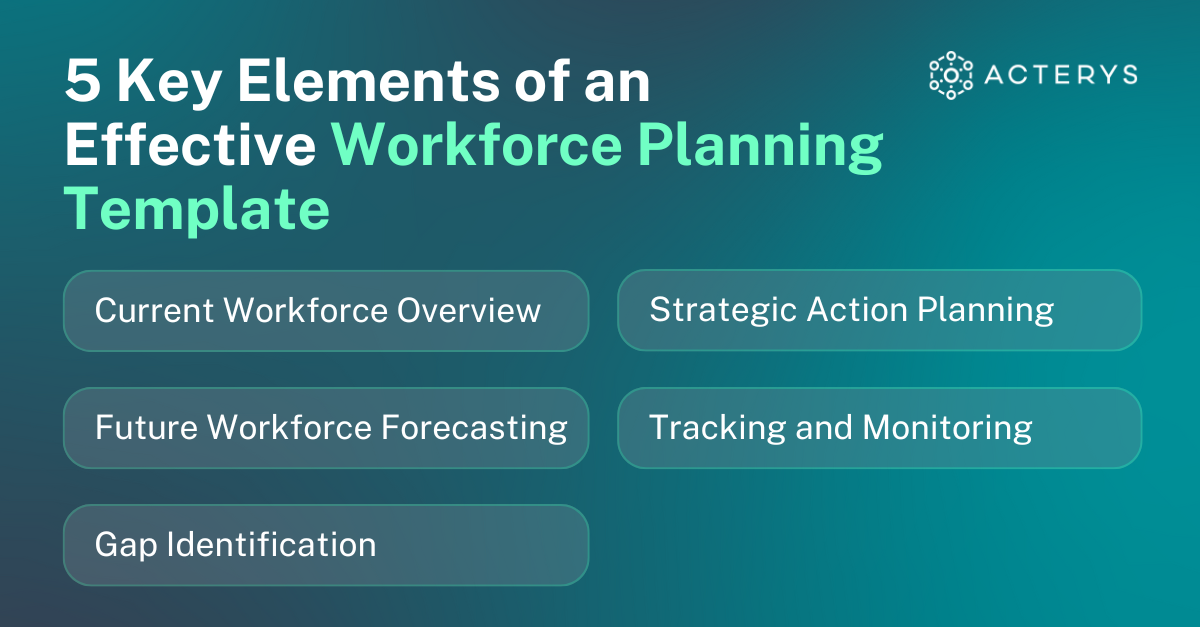
Table of Contents
Workforce planning is a crucial part of ensuring that your business has the right people, with the right skills, at the right time. As businesses grow and evolve, workforce needs change, and planning ahead becomes key to navigating challenges. But with so much workforce data living in so many places, pulling the right information together can be a challenge. That’s where workforce planning templates can help.
A workforce planning template is a structured framework designed to help you gather, organize, and analyze workforce data. It’s a tool that helps you bring together the data you need for an effective workforce planning process, from understanding your current team to planning for your future workforce.
Discover how workforce planning templates support strategic HR decisions, and how to implement templates in your workforce planning process.
3 Benefits of Using a Workforce Planning Template
A workforce planning template is a powerful tool for organizing and optimizing your approach to workforce management. A workforce planning template — whether a simple planning template or a more detailed workforce analysis template — provides the structure you need to gather insights, analyze key data, and develop strategies that align with organizational priorities. By leveraging a template, you can take a more focused and effective approach to planning for your team’s current and future needs.
Centralizes Workforce Data
A template helps you consolidate information like headcount, skill sets, and turnover rates into a single view. This organization makes it easier to spot trends, analyze data, and prepare for strategic decisions.
Supports Gap Identification
By bringing the right information together in the right place, a template provides a starting point for a skill gap analysis or workforce gap analysis. This process enables you to identify gaps in staffing or skills more efficiently.
Provides Actionable Direction
A template organizes your findings and facilitates next steps, offering space to outline workforce development plan templates, hiring plans, and strategies for succession planning. It gives you a framework to turn analysis into action.
5 Key Elements of an Effective Workforce Planning Template
An effective workforce planning template lays the foundation for aligning talent strategies with organizational goals. Paired with workforce planning systems, it helps consolidate data, track progress, and drive actionable insights for future workforce needs.
A robust workforce planning template includes these critical elements:
- Current Workforce Overview: Capture headcount, demographics, and skill sets to evaluate your workforce’s current capabilities.
- Future Workforce Forecasting: Use business projections and market trends to determine future staffing needs.
- Gap Identification: Perform a workforce gap analysis to pinpoint skills gaps, headcount shortages, or talent surpluses.
- Strategic Action Planning: Develop targeted plans for recruitment, training, or internal mobility to address gaps.
- Tracking and Monitoring: Include KPIs to measure progress and update the plan as business needs evolve.
These components form the backbone of effective workforce planning and can be customized for your organization’s unique challenges.

Is Excel the Best Option for Workforce Planning Templates?
Microsoft Excel is a popular choice for workforce planning because of its flexibility and accessibility. A workforce planning template xls or Excel file provides several benefits:
- Flexibility and Accessibility: Excel is widely available and easy to use, making it a convenient choice for workforce planning.
- Customizable Fields: Tailor templates to include metrics like headcount, turnover rates, or skills gaps to fit your organization’s specific needs.
- Automated Calculations: Leverage formulas to forecast headcount, calculate budget constraints, or track progress toward KPIs.
- Data Visualization: Create charts and graphs to build dashboards that effectively communicate insights on workforce gaps and progress.
While it’s an excellent starting point for many HR teams, Excel does have limitations:
- Limited Scalability: Excel may struggle to handle large datasets or complex workforce planning needs.
- Lack of Real-Time Data Integration: It requires manual updates and doesn’t automatically sync with HRIS or other systems.
- Basic Analytics: Advanced analytics and scenario modeling are limited compared to dedicated workforce planning systems.
Starting a workforce planning template in Excel is a solid starting point for many HR teams but may need to be supplemented or replaced as planning requirements grow.
Alternatives to Excel Workforce Planning Templates
If your workforce planning needs exceed Excel’s capabilities, consider exploring tools that offer advanced analytics, automation, and real-time data integration to streamline your process.
Power BI
Power BI is ideal for organizations that prioritize business intelligence and data visualization. Making the switch from Excel to Power BI unlocks new features, such as interactive dashboards for tracking metrics like headcount, turnover, and skills gaps. Its real-time updates and scenario modeling features make it a powerful tool for strategic workforce planning, especially when data-driven insights are critical to achieving your goals.
HCM Workforce Planning Modules
Workforce planning modules within human capital management (HCM) systems, such as Workday, BambooHR, or Oracle HCM Cloud, offer a convenient alternative. These modules include pre-built templates for strategic workforce plan samples, headcount forecasting, and skills gap analysis. As part of a larger HR technology suite, they integrate seamlessly with payroll, benefits, and performance data while automating manual processes like data entry and reporting.
xP&A Platforms
For more advanced needs, extended planning and analysis (xP&A) platforms like Acterys combine workforce planning templates with robust analytics and scenario modeling tools. Acterys helps HR leaders evaluate strategies such as hiring plans or training initiatives, offering flexible solutions for strategic workforce planning. Acterys’ deep integration with Power BI and Excel makes it especially valuable for organizations aiming to align workforce planning and analytics with long-term business goals.
How to Implement a Workforce Planning Template
Templates are designed to streamline talent decisions and direct your workforce planning efforts. Follow these steps to get the most out of your strategic workforce planning template.
Input Current Workforce Data
Start by filling in key metrics like headcount, demographics, and skill sets to establish a clear baseline of your workforce’s current capabilities.
Forecast Future Needs
Use the template to project staffing and skill requirements based on upcoming business goals, market trends, or anticipated operational changes.
Perform Gap Analysis
Compare current data with forecasted needs to identify specific workforce gaps, such as skill shortages, talent surpluses, or leadership voids.
Develop and Prioritize Action Plans
Populate fields for recruitment, training, or mobility strategies, and prioritize actions that address critical gaps while aligning with business objectives.
Monitor and Update Regularly
Use KPIs in the template to track progress, adjust timelines, and ensure workforce strategies evolve with changing business demands.
Simplify Workforce Planning With a Clear Framework
Workforce planning templates are powerful tools that can make your workforce management more strategic and efficient. By saving time, ensuring consistency, and providing critical insights, these templates enable you to jumpstart your talent strategy and prepare for future challenges with confidence.
With Acterys, you can easily address all your workforce planning and analytics needs. Ready to see how a unified approach can help your organization? Request a personalized demo today.




